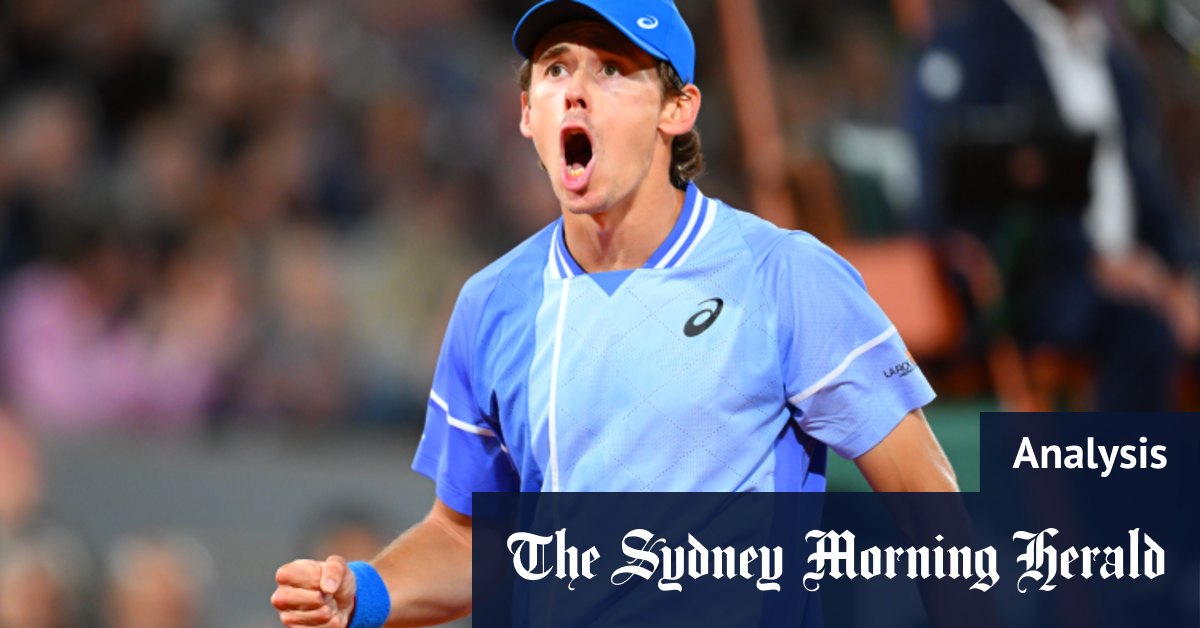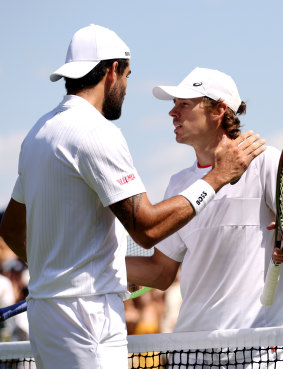


The Sydneysider has 315 fewer points than Rublev to “defend” this grasscourt season. Another factor is de Minaur’s quarter-final effort from ’s-Hertogenbosch last year is not one of his 19 countable tournaments, given he performed better elsewhere, but a title run there in 2024 would go towards his ranking.
There is less than a 1000-point buffer between Rublev and Tsitsipas, who will slide to No.11 on Monday, with Casper Ruud, Hurkacz, de Minaur and Grigor Dimitrov in between.
The Wimbledon winner receives 2000 ranking points, then there is 1200 for the runner-up, 720 for semi-finalists and 360 for quarter-finalists, right down to 10 points for losing in the first round.
6. Andrey Rublev (4710 ranking points; 660 points to defend until the end of Wimbledon)
7. Casper Ruud (TBC; 45 to defend)
8. Hubert Hurkacz (3995; 270 to defend)
9. Alex de Minaur (3845; 345 to defend)
10. Grigor Dimitrov (3775; 290 to defend)
11. Stefanos Tsitsipas (3740; 225 to defend)
De Minaur gained something even more valuable than ranking points during the rain-soaked previous fortnight on Parisian clay. He learned what he was capable of – and everyone else did, too.
Swedish great Mats Wilander even predicted that de Minaur, once dismissed as Lleyton Hewitt-lite, would win a grand slam title, with his best chance likely to come on the Australian Open’s slick hardcourts.
Alex de Minaur (right) is emerging from Lleyton Hewitt’s shadow with his own lofty achievements.Credit: Getty Images
No Australian man has won his home major since Mark Edmondson in 1976, so a de Minaur triumph would be celebrated every bit as much as Ash Barty’s drought-busting victory in the women’s singles two years ago.
Zverev, who ended de Minaur’s Roland-Garros run, also labelled him a “top contender” to qualify for the first time for the ATP Tour Finals, the exclusive end-of-year event for the eight best-performed players each season.
Loading
De Minaur told this masthead in March that the Tour Finals were on his 2024 hit list, along with breaking into the top five. He sits seventh in the “Race to Turin” three weeks out from Wimbledon, where he will hope, or even expect, to go deeper than ever before.
Australian tennis lost Barty to an early retirement, while 2022 Wimbledon finalist Nick Kyrgios has played just once in the last 20 months because of knee and wrist injuries, but de Minaur has seamlessly picked up the slack as the resident standard-bearer.
Thanasi Kokkinakis speaks glowingly about Demon’s work ethic and attitude, and doubles legend Todd Woodbridge echoed those sentiments last week when he said he was an “amazing example” of what hard work can accomplish.
The nation’s resolute tennis star appears to have an unshakeable mental fortitude and inner-belief, but perhaps lost amid the elation of his unlikely surge to the Roland-Garros last eight was his reaction to it all.
“It’s been a complete shock to the system, to everything I ever believed in,” de Minaur said after coming from a set down to defeat Medvedev, who had won six of their previous eight duels.
De Minaur started the claycourt major with a losing record on the surface – compared to his 65 per cent win rate on hardcourts and 61 per cent on grass – and having never advanced beyond the second round at Roland-Garros.
It was understandable with that context that his expectations were modest, albeit he opined early in the tournament he was a “completely different player” these days on the red dirt.
Medvedev was also central to him cracking the code on top-five rivals. De Minaur lost his first 18 matches against opponents ranked that highly until a victory over the Russian leviathan at the Paris Masters two years ago.
Since then, de Minaur counts six more top-five wins from 16 opportunities, which is a very respectable hit rate against such opposition.
Those scalps read impressively: world No.1 Novak Djokovic, Rafael Nadal, Rublev (twice) and Medvedev (twice). The fourth-round defeat of Medvedev at Roland-Garros was the most significant because it was his only one of those at a grand slam.
De Minaur’s return as the world No.9 should afford him friendlier draws and has him on track for a top-eight seeding at Wimbledon, particularly with Djokovic in doubt after knee surgery.
A potential top-eight seeding would mean the 25-year-old does not face a higher-ranked opponent until the quarter-finals.

Matteo Berrettini eliminated de Minaur at Wimbledon last year.Credit: Getty Images
He lost his fourth-round clash with Chilean Cristian Garin from two sets up at the London grand slam two years ago before going down to Berrettini in the second round last year. At the time, that Berrettini loss – six months after being on the wrong end of a Djokovic masterclass – seemed another bitter dose of reality for de Minaur’s lot in the tennis world. Instead, those results were just bumps on the road to where he is now.
This masthead’s in-depth look last week at de Minaur’s upgraded arsenal showed he was hitting his first serve far harder and playing more aggressively, including more regularly standing closer to the baseline on return.
He has also transformed his second serve into an unlikely weapon. He has the sixth-best second-serve winning percentage in the past year, and it kept him in the contest for large parts of his quarter-final against Zverev.
De Minaur’s ability to win 16 of 21 second-serve points in the second set was a major reason he was so close to clinching the set and levelling the match.
Loading
“He’s always [been a fighter on court]. That hasn’t changed, for sure,” Zverev said.
“I think there are other areas he’s improved in. His serve has improved tremendously – his second serve, especially. He’s a great player … [and] he has improved a lot.”
However, de Minaur’s world-class return remains the heartbeat of his game.
The ATP’s official statistics rate him as the tour’s No.2 returner on a number of key metrics, which was evidenced at Roland-Garros, where both Medvedev and Zverev won a tournament-low percentage on their first serves.
More of the same will be crucial at Wimbledon if de Minaur is to reach the quarter-finals and beyond for the first time.
News, results and expert analysis from the weekend of sport sent every Monday. Sign up for our Sport newsletter.